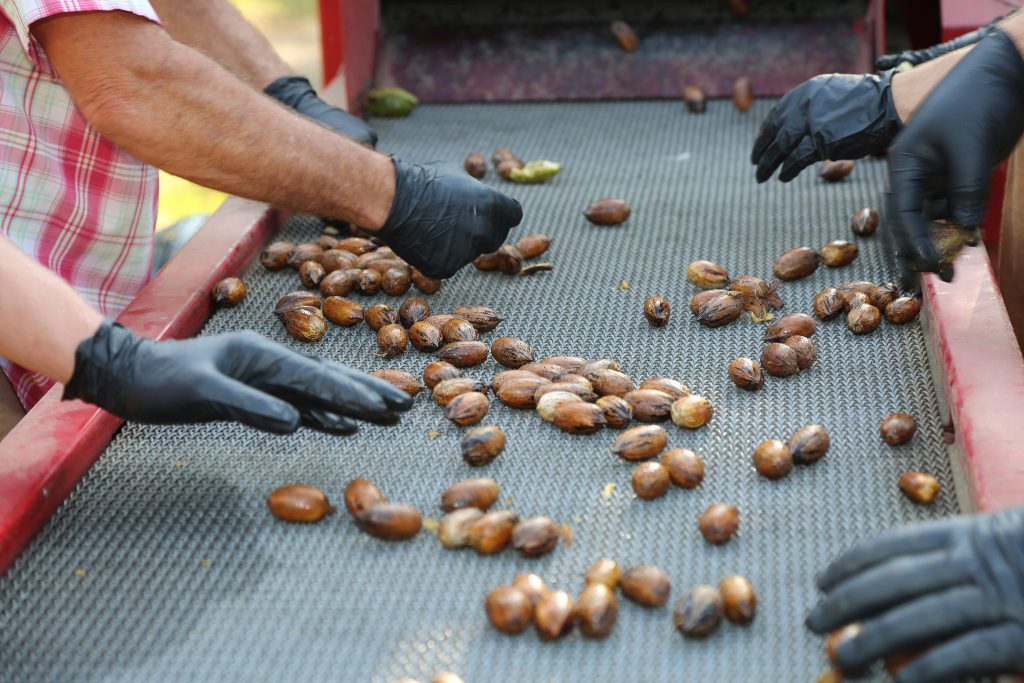
By Allison Fortner for CAES News
The international popularity of pecans is trending upward, but more reliable measures for guaranteeing quality during storage are needed to meet demand in Georgia, the top state for pecan production.
A review conducted by University of Georgia researchers identified scientific principles behind postharvest storage and handling techniques for pecans and revealed the need for a mathematical model to help producers predict quality under various conditions. This research will help U.S. pecan producers improve quality and increase shelf life.
In a recently published article in the journal Food Reviews International, researchers explored the science behind three indicators for optimal pecan quality: color, texture and lipid profile. The study was led by associate professor Fanbin Kong, the principal investigator on the project, and doctoral candidates Himanshu Prabhakar and Shruti Sharma in the UGA College of Agricultural and Environmental Sciences’ Department of Food Science and Technology.
“Georgia is the nation’s leading pecan-producing state. In recent years, Georgia-grown pecans have seen a rapid increase in sales in the international market, and a big portion of Georgia pecans are exported to other countries. The quality can deteriorate significantly during the long-term transportation and storage,” said Kong, who initially identified the need for in-depth research on postharvest pecan quality.
This review of current handling and storage practices is part of a larger research project funded by the U.S. Department of Agriculture Specialty Crop Block Grant program. The ultimate goal of the three-year project is to identify how factors such as relative humidity, temperature, packaging and processing influence quality changes and shelf life of pecans. The end product will be a mathematical model for determining pecan quality based on a variety of storage conditions.
Research Findings
Both Prabhakar and Sharma contributed to the journal review to identify factors that could adversely affect pecan quality and specify areas where research is lacking in relation to color, texture and lipid profile.
In the pecan industry, the quality and resulting price of pecans is most often assessed by color. However, texture and lipid profiles are important physical and chemical attributes that contribute to the consumer experience. The lipids give pecans their flavor profile and distinct aroma, while the texture indicates freshness and contributes to the consumer’s sensory experience.
“Understanding how one aspect of pecan leads to and relates to the other is quite an invigorating process as a food scientist because the pecan has its own unique chemistry, given the fact that it’s a plant food,” said Sharma.
Although pecan quality research has been conducted in the past, many of the findings are not useful in the Georgia pecan industry. For example, Prabhakar said that many existing storage studies kept pecans around 70 degrees Fahrenheit, but Georgia temperatures can range from below freezing to over 100 degrees Fahrenheit in storage facilities.
“They gave out the best conditions to preserve most of the pecan quality attributes in storage, but what they lacked was the actual scenario that pecan growers and distributors face,” said Prabhakar.
The review also found that other nuts have been more heavily researched in the past. Prakhabar said that although pecans are technically fruits, they compete in the same market as nuts.
“Given the fact that the researchers have done a lot of work in nuts in terms of storage and developing complex models to predict their changes in storage, it’s time that we should do that for pecan as well,” Prabhakar said.
Mathematical Model for the Industry
Based on the review findings, Kong and Prabhakar are developing a mathematical model by studying pecans under a variety of storage and handling conditions.
“We are developing a computational predictive model that can estimate the shelf life from different conditions (moisture, humidity, temperature, packaging methods, conditioning, etc.),” Kong said. “The model will be free for use by Georgia pecan growers and processors.”
Prabhakar explained that producers will not need to work with the complex equations the researchers are developing. Instead, a website will be created for producers to input factors such as temperature, relative humidity and pecan variety to receive information about the changes in quality that will occur over time. This will help pecan growers prepare accordingly, whether investing in different storage technology or adjusting sales timelines.
This model aims to help Georgia-grown pecans stay competitive and increase profitability in the growing global market. Consumers, both domestically and internationally, are recognizing pecans for their health benefits, which include vitamins, minerals and essential fatty acids. Millennials and Generation Z are also incorporating more nuts into their diets as they adopt plant-based food products.
“Given the fact that the popularity of plant-based foods is on the rise, research should be focused on understanding the chemistry of pecans and ways to advertise their health benefits in the international market,” said Sharma. “The future of this study depends on how effectively it will be communicated to the right audience at the right time to seek their feedback to incorporate the improvements.”
Kong, Prabhakar and Sharma hope their research will help Georgia’s pecan producers and help market pecans to new consumers.
“Food scientists are also developing novel products from pecans such as pecan butter. The increasing demand for pecans presents a great opportunity for the Georgia pecan industry. An improved postharvest handling and storage method will further enhance the competitiveness of Georgia-grown pecans,” Kong said.
For more information on the UGA Department of Food Science and Technology, visit foodscience.caes.uga.edu.









